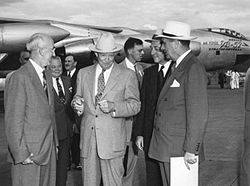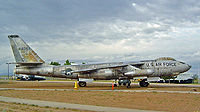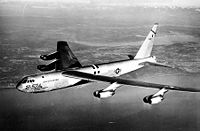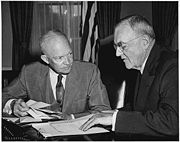.gif)
New Look (policy)
Encyclopedia
The New Look was the name given to the national security
policy of the United States during the administration of President
Dwight D. Eisenhower
. It reflected Eisenhower's concern for balancing the Cold War
military commitments of the United States with the nation's financial resources and emphasized reliance on strategic nuclear weapon
s to deter
potential threats, both conventional
and nuclear, from the Eastern Bloc
of nations headed by the Soviet Union
.
 In its narrowest sense, the New Look was the name applied to the Department of Defense
In its narrowest sense, the New Look was the name applied to the Department of Defense
budget for Fiscal Year 1955, which was the first defense budget prepared entirely by Eisenhower's own Joint Chiefs of Staff
. It was based on an extensive reappraisal of U.S. military requirements that began among Eisenhower and his closest advisers immediately following his election in November 1952. [1] It was formalized in National Security Council
document 162/2
(NSC 162/2), which Eisenhower approved on October 30, 1953.
NSC 162/2 reflected Eisenhower's desire for a "long-haul" approach to security planning that would maintain a more or less constant level of military preparedness, consistent with the health of the U.S. economy
.[2] In this respect, it differed from NSC 68
, approved by President Harry S. Truman on September 30, 1950. Truman's advisers believed that Soviet military capabilities would reach a maximum relative to those of the United States and its allies in the mid-1950s. Eisenhower, however, rejected the idea that one period would be any more dangerous than another and urged his planners to think in terms of a Soviet threat that was economic as well as military. He wanted to avoid, in his own words, "an unbearable security burden leading to economic disaster." [3] With the costly experience of the Korean War
in mind, Eisenhower was fearful that U.S. resources would be drained by Soviet-inspired regional conflicts. [4]

 In order to contain defense costs, the New Look brought about a shift in emphasis from conventional military capability to "air-atomic" capability in the form of the Strategic Air Command
In order to contain defense costs, the New Look brought about a shift in emphasis from conventional military capability to "air-atomic" capability in the form of the Strategic Air Command
within a scaled-down overall military establishment. Land and naval forces were cut. Continental air defense was expanded. Although strategic air power attained a lower level than the Truman administration had projected, it became the centerpiece of U.S. security thinking, embodied in the doctrine of "Massive Retaliation
." Summarized in the popular slogan "more bang for the buck," Massive Retaliation was intended to be both a deterrent to an enemy and an economy of scale if deterrence failed. [5]
The doctrine was proclaimed in its most absolute form by Secretary of State
John Foster Dulles
in a speech before the Council on Foreign Relations
on January 12, 1954, in which he said, "Local defenses must be reinforced by the further deterrent of massive retaliatory power [emphasis added].6 Dulles continued:
have pointed out that the doctrine was not credible in the face of "less-than-total challenges" such as the Soviet intervention in the 1956 Hungarian Revolution
, and that whatever credibility it might have had diminished steadily as Soviet strategic power grew.[9] Furthermore, it theoretically provided the Soviet Union with an incentive to strike first to disarm the United States.
 The refusal of the United States to act to prevent the defeat of France
The refusal of the United States to act to prevent the defeat of France
by the Communist
-led Viet Minh
at the Battle of Dien Bien Phu
, just four months after the Dulles speech, was proof that a situation of "mutual deterrence" had developed with the Soviet Union in which the use of strategic nuclear weapons for any purpose other than to respond to a direct attack on one's homeland or on one's major allies was out of the question. Defense planners, therefore, began shaping a "new" New Look marked by emphasis on strategic "sufficiency," not superiority; on tactical
nuclear weapons to fight "limited wars;" and on standing forces as opposed to reserves.[10] The emphasis was still primarily on nuclear weapons and the justification was still that of economy, but a shift toward what would later be called "flexible response
" had begun.
The new approach was embodied in NSC 5440, finalized in December 1954, which stated:
According to historian Campbell Craig:
National security
National security is the requirement to maintain the survival of the state through the use of economic, diplomacy, power projection and political power. The concept developed mostly in the United States of America after World War II...
policy of the United States during the administration of President
President of the United States
The President of the United States of America is the head of state and head of government of the United States. The president leads the executive branch of the federal government and is the commander-in-chief of the United States Armed Forces....
Dwight D. Eisenhower
Dwight D. Eisenhower
Dwight David "Ike" Eisenhower was the 34th President of the United States, from 1953 until 1961. He was a five-star general in the United States Army...
. It reflected Eisenhower's concern for balancing the Cold War
Cold War
The Cold War was the continuing state from roughly 1946 to 1991 of political conflict, military tension, proxy wars, and economic competition between the Communist World—primarily the Soviet Union and its satellite states and allies—and the powers of the Western world, primarily the United States...
military commitments of the United States with the nation's financial resources and emphasized reliance on strategic nuclear weapon
Nuclear weapon
A nuclear weapon is an explosive device that derives its destructive force from nuclear reactions, either fission or a combination of fission and fusion. Both reactions release vast quantities of energy from relatively small amounts of matter. The first fission bomb test released the same amount...
s to deter
Deterrence theory
Deterrence theory gained increased prominence as a military strategy during the Cold War with regard to the use of nuclear weapons, and features prominently in current United States foreign policy regarding the development of nuclear technology in North Korea and Iran. Deterrence theory however was...
potential threats, both conventional
Conventional weapon
The terms conventional weapons or conventional arms generally refer to weapons that are in relatively wide use that are not weapons of mass destruction, such as nuclear, chemical, and biological weapons. Conventional weapons include small arms and light weapons, sea and land mines, as well as ...
and nuclear, from the Eastern Bloc
Eastern bloc
The term Eastern Bloc or Communist Bloc refers to the former communist states of Eastern and Central Europe, generally the Soviet Union and the countries of the Warsaw Pact...
of nations headed by the Soviet Union
Soviet Union
The Soviet Union , officially the Union of Soviet Socialist Republics , was a constitutionally socialist state that existed in Eurasia between 1922 and 1991....
.
History

United States Department of Defense
The United States Department of Defense is the U.S...
budget for Fiscal Year 1955, which was the first defense budget prepared entirely by Eisenhower's own Joint Chiefs of Staff
Joint Chiefs of Staff
The Joint Chiefs of Staff is a body of senior uniformed leaders in the United States Department of Defense who advise the Secretary of Defense, the Homeland Security Council, the National Security Council and the President on military matters...
. It was based on an extensive reappraisal of U.S. military requirements that began among Eisenhower and his closest advisers immediately following his election in November 1952. [1] It was formalized in National Security Council
United States National Security Council
The White House National Security Council in the United States is the principal forum used by the President of the United States for considering national security and foreign policy matters with his senior national security advisors and Cabinet officials and is part of the Executive Office of the...
document 162/2
NSC 162/2
The United States National Security Council document NSC 162/2 of 30 October 1953 defined Cold War policy during the Dwight D. Eisenhower administration – the New Look national security policy...
(NSC 162/2), which Eisenhower approved on October 30, 1953.
NSC 162/2 reflected Eisenhower's desire for a "long-haul" approach to security planning that would maintain a more or less constant level of military preparedness, consistent with the health of the U.S. economy
Economics
Economics is the social science that analyzes the production, distribution, and consumption of goods and services. The term economics comes from the Ancient Greek from + , hence "rules of the house"...
.[2] In this respect, it differed from NSC 68
NSC-68
National Security Council Report 68 was a 58-page formerly-classified report issued by the United States National Security Council on April 14, 1950, during the presidency of Harry S. Truman. Written during the formative stage of the Cold War, it was top secret until the 1970s when it was made...
, approved by President Harry S. Truman on September 30, 1950. Truman's advisers believed that Soviet military capabilities would reach a maximum relative to those of the United States and its allies in the mid-1950s. Eisenhower, however, rejected the idea that one period would be any more dangerous than another and urged his planners to think in terms of a Soviet threat that was economic as well as military. He wanted to avoid, in his own words, "an unbearable security burden leading to economic disaster." [3] With the costly experience of the Korean War
Korean War
The Korean War was a conventional war between South Korea, supported by the United Nations, and North Korea, supported by the People's Republic of China , with military material aid from the Soviet Union...
in mind, Eisenhower was fearful that U.S. resources would be drained by Soviet-inspired regional conflicts. [4]
Massive Retaliation and the New Look


Strategic Air Command
The Strategic Air Command was both a Major Command of the United States Air Force and a "specified command" of the United States Department of Defense. SAC was the operational establishment in charge of America's land-based strategic bomber aircraft and land-based intercontinental ballistic...
within a scaled-down overall military establishment. Land and naval forces were cut. Continental air defense was expanded. Although strategic air power attained a lower level than the Truman administration had projected, it became the centerpiece of U.S. security thinking, embodied in the doctrine of "Massive Retaliation
Massive retaliation
Massive retaliation, also known as a massive response or massive deterrence, is a military doctrine and nuclear strategy in which a state commits itself to retaliate in much greater force in the event of an attack.-Strategy:...
." Summarized in the popular slogan "more bang for the buck," Massive Retaliation was intended to be both a deterrent to an enemy and an economy of scale if deterrence failed. [5]
The doctrine was proclaimed in its most absolute form by Secretary of State
United States Secretary of State
The United States Secretary of State is the head of the United States Department of State, concerned with foreign affairs. The Secretary is a member of the Cabinet and the highest-ranking cabinet secretary both in line of succession and order of precedence...
John Foster Dulles
John Foster Dulles
John Foster Dulles served as U.S. Secretary of State under President Dwight D. Eisenhower from 1953 to 1959. He was a significant figure in the early Cold War era, advocating an aggressive stance against communism throughout the world...
in a speech before the Council on Foreign Relations
Council on Foreign Relations
The Council on Foreign Relations is an American nonprofit nonpartisan membership organization, publisher, and think tank specializing in U.S. foreign policy and international affairs...
on January 12, 1954, in which he said, "Local defenses must be reinforced by the further deterrent of massive retaliatory power [emphasis added].6 Dulles continued:
The way to deter aggression is for the free community to be willing and able to respond vigorously at places and with means of its own choosing.
...
Now the Department of Defense and the Joint Chiefs of Staff can shape our military establishment to fit what is our policy, instead of having to try to be ready to meet the enemy's many choices. That permits of a selection of military means instead of a multiplication of means, As a result, it is now possible to get, and share, more basic security at less cost.[7]
Criticism of Massive Retaliation
What Dulles implied was that the United States was prepared to respond to a Soviet-backed conventional threat anywhere with a nuclear strike against the Soviet Union itself. [8] Critics of Massive Retaliation such as historian John Lewis GaddisJohn Lewis Gaddis
John Lewis Gaddis is a noted historian of the Cold War and grand strategy, who has been hailed as the "Dean of Cold War Historians" by The New York Times. He is the Robert A. Lovett Professor of Military and Naval History at Yale University. He is also the official biographer of the seminal 20th...
have pointed out that the doctrine was not credible in the face of "less-than-total challenges" such as the Soviet intervention in the 1956 Hungarian Revolution
1956 Hungarian Revolution
The Hungarian Revolution or Uprising of 1956 was a spontaneous nationwide revolt against the government of the People's Republic of Hungary and its Soviet-imposed policies, lasting from 23 October until 10 November 1956....
, and that whatever credibility it might have had diminished steadily as Soviet strategic power grew.[9] Furthermore, it theoretically provided the Soviet Union with an incentive to strike first to disarm the United States.
The "New" New Look

France
The French Republic , The French Republic , The French Republic , (commonly known as France , is a unitary semi-presidential republic in Western Europe with several overseas territories and islands located on other continents and in the Indian, Pacific, and Atlantic oceans. Metropolitan France...
by the Communist
Communist Party of Vietnam
The Communist Party of Vietnam , formally established in 1930, is the governing party of the nation of Vietnam. It is today the only legal political party in that country. Describing itself as Marxist-Leninist, the CPV is the directing component of a broader group of organizations known as the...
-led Viet Minh
Viet Minh
Việt Minh was a national independence coalition formed at Pac Bo on May 19, 1941. The Việt Minh initially formed to seek independence for Vietnam from the French Empire. When the Japanese occupation began, the Việt Minh opposed Japan with support from the United States and the Republic of China...
at the Battle of Dien Bien Phu
Battle of Dien Bien Phu
The Battle of Dien Bien Phu was the climactic confrontation of the First Indochina War between the French Union's French Far East Expeditionary Corps and Viet Minh communist revolutionaries. The battle occurred between March and May 1954 and culminated in a comprehensive French defeat that...
, just four months after the Dulles speech, was proof that a situation of "mutual deterrence" had developed with the Soviet Union in which the use of strategic nuclear weapons for any purpose other than to respond to a direct attack on one's homeland or on one's major allies was out of the question. Defense planners, therefore, began shaping a "new" New Look marked by emphasis on strategic "sufficiency," not superiority; on tactical
Military tactics
Military tactics, the science and art of organizing an army or an air force, are the techniques for using weapons or military units in combination for engaging and defeating an enemy in battle. Changes in philosophy and technology over time have been reflected in changes to military tactics. In...
nuclear weapons to fight "limited wars;" and on standing forces as opposed to reserves.[10] The emphasis was still primarily on nuclear weapons and the justification was still that of economy, but a shift toward what would later be called "flexible response
Flexible response
Flexible response was a defense strategy implemented by John F. Kennedy in 1961 to address the Kennedy administration's skepticism of Dwight Eisenhower's New Look and its policy of Massive Retaliation...
" had begun.
The new approach was embodied in NSC 5440, finalized in December 1954, which stated:
The ability to apply force selectively and flexibly will become increasingly important in maintaining the morale and will of the free world to resist aggression. As the fear of nuclear war grows, the United States and its allies must never allow themselves to get into the position where they must choose between (a) not responding to local aggression and (b) applying force in a way which our own people or our allies would consider entails undue risk of nuclear devastation. However, the United States cannot afford to preclude itself from using nuclear weapons even in a local situation, if such use. . . will best advance U.S. security interests. In the last analysis, if confronted by the choice of (a) acquiescing in Communist aggression or (b) taking measures risking either general war or loss of allied support, the United States must be prepared to take these risks if necessary for its security.[11]
According to historian Campbell Craig:
NSC 5440 was a fundamental revision of the earlier BNSP [Basic National Security Policy]. Its authors (a) renounced massive retaliation, (b) precisely articulated the strategy of "flexible response" as it would become known seven years later, and (c) predicted, in the last sentence, exactly the dilemma which the Eisenhower administration would face in Berlin four years hence.
[12]
Other reading
- Robert R. Bowie and Richard H. Immerman, Waging Peace: How Eisenhower Shaped an Enduring Cold War Strategy Oxford, New York: Oxford University Press, 1997. ISBN 0-19-506264-7
- Paul Y. Hammond, Organizing for Defense, Princeton, NJ: Princeton University Press, 1961.
- Richard G. Head and Ervin J. RokkeErvin J. RokkeErvin J. Rokke is a retired lieutenant general and retired President of Moravian College.Ervin Rokke completed his time at Moravian in the summer of 2006. At the commencement ceremonies that year, he received an honorary doctorate from the College. Mrs...
(eds.), American Defense Policy (3rd ed.), Baltimore: Johns Hopkins University Press 1975. ISBN 0-8018-1486-3 - William R. Kintner, Peace and the Strategy Conflict, New York: Frederick A. Praeger, 1967.
- Walter Millis (ed.), American Military Thought, Indianapolis: Bobbs-Merrill Co., 1966.
- Robert E. Osgood, Limited War, Chicago: University of Chicago Press, 1957.
- Warner R. Schilling, Paul Y. Hammond and Glenn H. Snyder, Strategy, Politics and Defense Budgets, New York: Columbia University Press, 1962. ISBN 0-231-02556-4
- Maxwell D. Taylor, The Uncertain Trumpet, New York: Harper & Row, 1960.
External links
- Herman S. Wolk, "The 'New Look'," Air Force Magazine, v. 65, no. 8, (August 2003)
- Summary: John Foster Dulles, "The Evolution of Foreign Policy," Department of State Bulletin 30 (January 25, 1954): 107-10
- Summary: John Lewis Gaddis, Strategies of Containment: A Critical Appraisal of Postwar American National Security (Oxford University Press, 1982)
- Documents on Canadian External Relations: UNITED STATES DEFENCE POLICY: A "NEW LOOK," February 2, 1954
- "The Rise and Fall of Massive Retaliation, January 1953–July 1955" from Campbell Craig, Destroying the Village: Eisenhower and Thermonuclear War (New York: Columbia University Press, 1998)

